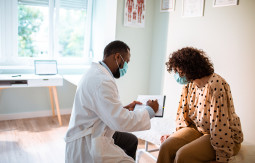Vulvovaginitis and vaginosis can cause serious complications during pregnancy.1-4
Bacterial vaginosis (BV), as well as vulvovaginal candidiasis (VVC) and Trichomonas vaginalis infection should be diagnosed and treated early to avoid potentially severe adverse health issues, especially during pregnancy.1-4
If left untreated, vaginitis can cause a pregnant woman to have preterm labor, give birth to a baby with a low birth weight and other adverse pregnancy outcomes.1-3
VVC has also been linked to pelvic inflammatory disease and TV to fertility issues.3,4
| Cause of vulvovaginitis | Associated complications |
|---|---|
| BV2 |
|
| VVC3 |
|
| TV |
|
Women with vaginitis are at higher risk of contracting STIs.1
1 out of 4 women with bacterial vaginosis alone or with concurrent candidiasis is co-infected with an STI.5
The risk of acquiring HIV is 2 to 3 times higher in women who have vaginitis.1
1 in 4 women
with bacterial vaginosis also has an STI.5
2 to 3 times
higher risk of acquiring HIV.1











